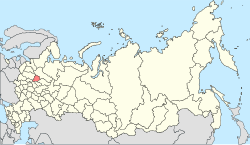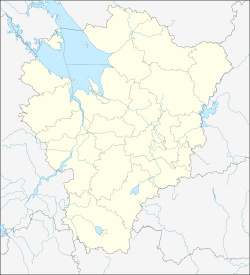Rybinsk
| Rybinsk (English) Рыбинск (Russian) |
|
|---|---|
| - City - | |
 View of the historic center from the Volga |
|
 Location of Yaroslavl Oblast in Russia |
|
|
|
|
|
|
|
|
|
|
| Administrative status (as of December 2011) | |
| Country | Russia |
| Federal subject | Yaroslavl Oblast |
| Administratively subordinated to | city of oblast significance of Rybinsk |
| Administrative center of | Rybinsky District, city of oblast significance of Rybinsk |
| Municipal status (as of December 2011) | |
| Urban okrug | Rybinsk Urban Okrug |
| Administrative center of | Rybinsk Urban Okrug, Rybinsky Municipal District |
| Mayor | Yury Lastochkin |
| Statistics | |
| Population (2010 Census) | 200,771 inhabitants |
| - Rank in 2010 | 93rd |
| Time zone | MSK (UTC+03:00) |
| First mentioned | 1071 |
| City status since | 1777 |
| Previous names |
Ust-Sheksna (until 1504), Rybnaya Sloboda (until 1777), Rybinsk (until 1946), Shcherbakov (until 1957), Andropov (until 1989) |
| Postal code(s) | 152900—152939 |
| Dialing code(s) | +7 4855 |
|
|
|
| on | |
Rybinsk (Russian: Рыбинск; IPA: [ˈrɨbʲɪnsk]) is the second largest city of Yaroslavl Oblast, Russia, which lies at the confluence of the Volga and Sheksna Rivers. Population: 200,771 (2010 Census);222,653 (2002 Census);251,442 (1989 Census).
Rybinsk is one of the oldest Slavic settlements on the Volga River. The place was first recorded by chroniclers in 1071 as Ust-Sheksna, i.e. "the mouth of the Sheksna". During this period the settlement was a regional center for craft and metal based produce and for trade. In the mid-13th century, Ust-Sheksna was laid waste by invading Mongols. For the next few centuries, the settlement was referred to alternatively as Ust-Sheksna or Rybansk. From 1504, it was identified in documents as Rybnaya Sloboda (literally: "the fishing village"). The name is explained by the fact that the settlement supplied the Muscovite court with choice sturgeons and sterlets. In the 17th century, when the sloboda was capitalizing on the trade of the Muscovy Company with Western Europe, it was rich enough to build several stone churches, of which only one survives to the present. More old architecture may be found in the neighborhood, including the very last of Muscovite three-tented churches (in the Alexandrov Hermitage) and the Ushakov family shrine (on Epiphany Island).
...
Wikipedia



